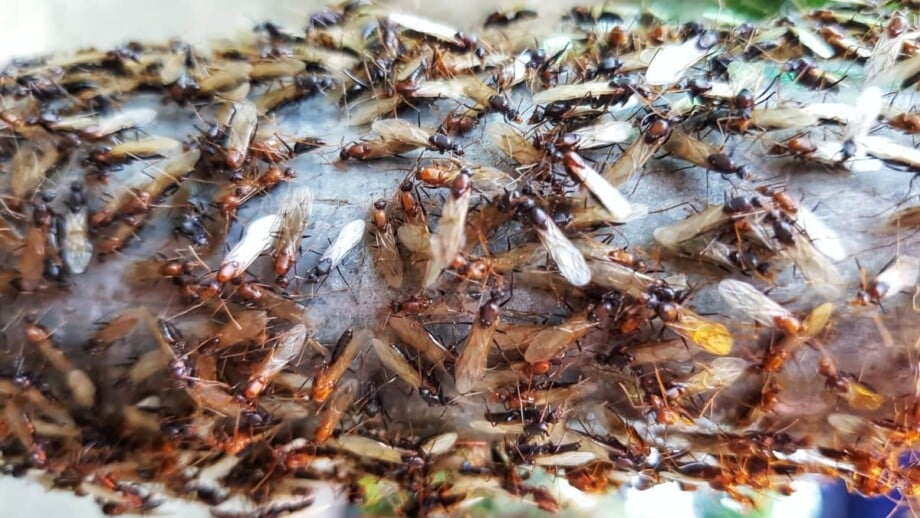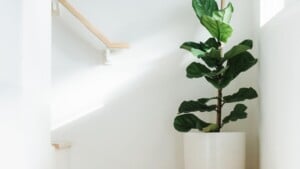Seeing severe termite damage is every homeowner’s worst nightmare. So it’s incredibly important to spot the signs of a termite infestation as soon as possible so that you can treat them and limit the damage they do.
According to the National Pest Management Association (NPMA), it’s estimated that termites cause over $5 billion in property damage each year in the United States. And, unfortunately, just about every property is at risk of termites in this country.
Learning the signs of termite damage can help reduce costs significantly. In this article, we go over 9 the early warning signs of termites and how to know if you have any on your property.
1. Flying Termites (Swarmers)
Seeing swarmers are generally one of the first signs of a termite infestation. Swarmers are termites that leave their nests in large groups and have wings.
These flying termites are males and females that have left the nest in search of a suitable mate, and this could be close to or in your home.
Several species swarm at night and are drawn to lights. Some species will swarm during the day, but all drywood termites swarm after rain at specific times of the year.
And so, if you see termite swarmers, this is a sign of a termite infestation.

2. Discarded Wings
Another obvious sign of a termite problem is the presence of discarded wings. Swarmers shed their wings after taking flight.
If you have termites, you might find these piles of wings around the foundation of your home, either inside or outside.

3. Hollow or Blistering Wood
Termite activity may also be indicated by wood that is blistering or sounds hollow. Termites often eat wood from the inside out, leaving just the paint or a thin veneer of wood behind.
Termite damage will make an area sound hollow or papery when you knock or tap on it. This is due to the interior wood being eaten away in part or in its entirety.
You may also find cracks in the walls that don’t make sense. Wooden walls contain cellulose, which termites feed on, thus any visible cracks could be a sign of an infestation.
They can also damage baseboards and laminate flooring. Checking underneath the flooring may help to find termite activity. Damaged flooring may blister and sag in some places. Check to see if the floor seems spongier than usual or if it springs back to the touch more than usual.
Termites can damage wooden ceilings, beams, architraves, and rafters in attics just as much as they can damage wood near the ground. Check the ceiling and cornices for cracks. Even if you live in a brick house, you should still check for them because they can still cause significant damage.

4. Frass
The presence of frass is an important sign of termites, particularly drywood termites. Frass is wood-colored termite droppings that are easily mistaken for sawdust by the untrained eye. This termite infestation sign is looked for during termite inspections.
Drywood termites, unlike subterranean termites, do not construct their tunnels using their feces. Instead, they push it out of little holes near the nest’s entrances.
This is why you’ll see a dark powdery substance and small black marks in and around the area they are infesting.

5. Mud Tubes
The most typical sign of termite activity due to subterranean termites is the presence of mud tubes. Mud tubes are used to get from the ground to a food source. They are found attached to building structures, usually close to the foundation.
Mud tubes are typically located close to the foundations of your home and serve as protection for termites. They are easily identified with the naked eye. Subterranean termite species often build these moisture-retaining tubes out of soil and termite droppings.
Eliminate moisture-rich areas and store firewood, mulch, and wood chips away from the residence to avoid attracting termites.

6. Hard-to-Open Windows or Tight Fitting Doors
Windows and doors that are too stiff to open and close can be a symptom of termites, just as they are often a sign of too much moisture or heat.
When they eat and tunnel through door and window frames, they leave behind moisture that makes the wood warp, making it hard to open doors and windows.
7. Chewing or Head Banging Noises
Clicking sounds coming from the walls are another sign of termites.
When the colony is threatened, the termite soldiers bang their heads on the wood or shake their bodies to warn their fellow termites.
Termites are sensitive creatures with organs at the base of their antennae and on their tibia that can pick up on vibrations and sounds.
The worker termites, who love to chew your woodwork, are loud and noisy eaters. Termites can be heard nibbling on wood if you place your ear close to it.
8. Termite Holes
Tiny round holes in wood are one of the most common signs of these wood-destroying insects.. When termites swarm to start new colonies, the swarmers leave the nest. This is when they make termite exit holes are made.
The average size of termite exit holes is 1/8 of an inch. When the swarmer leaves the nests, the nymphs inside will use frass to make a paste that will fill the holes.
Uncovered termite holes are uncommon, however, wood that has been thrown out can sometimes be seen in a pile and resembles small mustard seeds. Typically, a termite expert is required to identify these termite holes.
Often, the presence of these tiny holes is a sign of the presence of drywood termites.

9. Bubbling Paint
Drywall contains paper, and paper contains cellulose, which is the primary food source for termites.
As termites consume drywall, they leave behind little trails on the surface and within the drywall. Where the termites have eaten their way through your drywall or wallpaper, you can find pin-sized holes.
Pinholes in drywall made by termites are covered with a tiny bit of dirt, and bubbling under your wallpaper or paint is a clear sign that termites are there.

Other Pest Control Guides from Planet Natural:
Termite Control: How to Get Rid of Termites Effectively
Maggot Control Made Easy: Solutions for Inside and Outside Spaces











